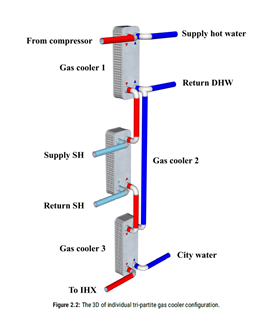Experimental results of a tri-partite gas cooler
The leakage of refrigerants such as hydrofluorocarbons (HFCs) used as working fluids in vapour compression systems contributes to global warming. The clear phase-out pathway of HFCs is listed in the Kigali amendment to the Montreal Protocol and the EU F-Gas regulation. This will support achieving the Paris Agreement goal to limit global warming below 2, preferably 1.5 degrees Celsius, compared to pre-industrial levels.
The use of natural and environmentally friendly refrigerants with low Global Warming Potential (low GWP) such as hydrocarbons, water, ammonia and carbon dioxide (CO2) has attracted much attention to mitigate the greenhouse gas emissions from refrigeration, air-conditioning and heat pumping systems.
Norwegian University of Science and Technology (NTNU) from Trondheim (Norway) has developed in the frame of TRI-HP project a single tri-partite gas cooler unit for carbon dioxide heat pumps. It includes three brazed plate heat exchangers developed by ALFA LAVAL. An innovative design was selected to simplify the heat pump layout and reduce the piping requirements.
A schematic diagram of the tri-partite gas cooler test facility located at NTNU is shown on the figure below.
The designed tri-partite gas cooler was experimentally investigated considering differing operating conditions for preheating domestic hot water (DHW), space heating (SH) and preheating of DHW.

NTNU researchers have investigated the tri-partite brazed plate gas cooler in a transcritical carbon dioxide (CO2) heat pump water heater system. The gas cooler was studied at a steady state for only SH operation, only DHW operation, and simultaneous DHW+SH operation.
A heat pump unit was considered with a heat duty of 10 kW, 8 kW, and 10 kW under DHW, SH, and DHW+SH respectively to provide water in the DHW and SH operation mode, with temperatures up to 70 °C and 35°C, respectively.
The influence of different parameters like the CO2 inlet pressure, CO2 and water mass flow rates, and water inlet temperature on the total heat transfer coefficient was analysed in detail. As shown by the experimental results, the gas cooler shows promising performance and it is more compact than other designs.
The transcritical CO2 heat pump system developed in the TRI-HP project proved to be a promising technology for SH and DHW preparation.
In comparison with the traditional water heaters, a heat pump water heater using CO2 as a refrigerant can take the advantage of the high temperature glide of CO2 when it is cooled down from a vapour-like region to a liquid-like region in a gas cooler.
The data obtained in the present experimental study for the characteristics of CO2 are of significance in designing and optimizing the transcritical CO2 systems.
A journal paper with the title "Experimental study on the characteristics of supercritical carbon dioxide cooled in a tripartite brazed plate gas cooler" is presenting more in detail the results and it is currently under review at the journal Applied Thermal Engineering.